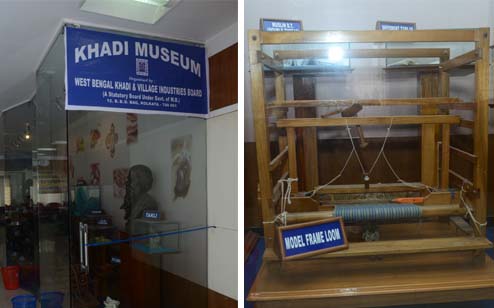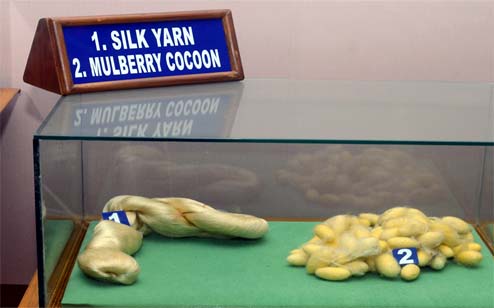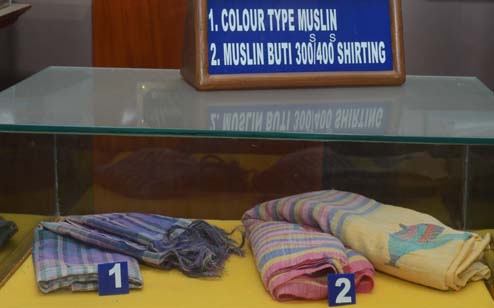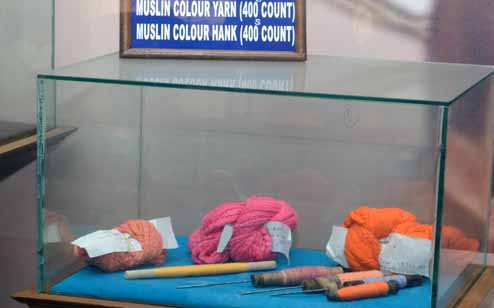MUSEUM
 | This was a part of the Golden Jubilee Celebration of the Board. This Museum contains the heritage item of Bengal Muslin Cloth of 500 COUNT & is being passed through a ring which is exhibited. The most attractive Bengal famous saree “Baluchori” has also been found in the Khadi Museum. Moreover a chronological evolution of Charkas namely “kishan Charka” to now-a-days Charka in 8 Spindle (NMC) have been approached attraction to the Museum. This Museum has also been glorified by the presence of halfbust bronze statue of Kabiguru Rabindranath Tagore, the great scientist, Acharya Prafulla Ch. Roy & the great leader Mahatma Gandhi. The total outlook is so beautiful that a team of dignitaries of Bangladesh came, saw & praised highly about the Khadi Museum of WBKVIB. |
 | SPINDLE: ‘Stage’ is denoted by the word ‘Spindle’ e.g. 6 spindle means six ‘Stages’ and ‘Count’ may be increased or decreased through the changing of Pinion gear. |
 | SILK YARN & MULBERRY COCOON: Silk is a natural protein fiber which is obtained from the cocoons of the silkworm. It is a natural filament produced by the salivary glands of silkworms, which are a type of moth that feeds on the mulberry bush. They spin their cocoons using a complex set of mechanisms within their bodies when they change from larva into pupa. The origin of the silk dates back to 2600 B.C and the country producing the best quality of silk is China which is also known to be the birth place for the silk fibre. It is protein in nature and so exhibits the natural characteristics which resemble the wool fiber. The cultivation and manufacturing process of silk fiber is a costly affair, making silk a costly fiber. The different varieties of silk produced in India from different species of silkworm are mulberry silk, muga silk, eri silk and tussar silk.
|
The casing formed by the caterpillars of silkworms before metamorphosis into a pupa; the raw material for obtaining natural silk.The cocoons of the mulberry silkworm have the greatest commercial value, but cocoons of the Chinese oak silkworm, the ailanthus silkworm, and other silkworms are also used. The caterpillars of these silkworms secrete a double silk thread consisting of the protein fibroin, the sticky substance sericin, pigment, and other substances. In winding its cocoon on a cocoon support the caterpillar lays the thread around its body in the form of the figure eight, and these loops constitute the basic, reelable part of the casing. A continuous silk thread can reach a length of 1,200 m and a thickness of 20–30 micrometers. The cocoons of the mulberry silkworm are oval, spindle-shaped, or cylindrical; cocoons of the oak silkworm are less regular in shape. The cocoons selected for reeling are treated with hot air or steam to kill the pupa and prevent its metamorphosis into a moth, which damages the cocoon as it emerges. The cocoons are then dried so that they will not spoil during storage. The weight of a live cocoon ranges from 1.5 to 3.5 g, and the weight of the reelable casing is 350–550 mg. The cocoon of females is on the average 20 percent heavier than that of males.
 | MUSLIN: The word "Muslin" is derived from the name of the ancient port town "Maisolos". Muslin clothes were traded by ancient Greeks and Romans from the East Indian port town Masulipatnam, known as Maisolos and Masalia in ancient times and the name 'Muslin' originated from the name Maisolos. The chief merchandise of Maisolia, eagerly sought for by the merchants from the Roman world, was muslin-so favourite a wear with fashionable Roman ladies of that age that a legend has it that an ounce of muslin used to sell in Rome for an ounce of gold. Because of this trade Roman gold coins poured into Maisolia. |
 | During the 17th and 18th centuries, Mughal Bengal emerged as the foremost muslin exporter in the world, with Mughal Dhaka as capital of the worldwide muslin trade. During the Roman period Khadi muslin was introduced in Europe and a vast amounts of fabrics were traded to Europe for many centuries. It became highly popular in 18th-century France and eventually spread across much of the Western world. During British colonial rule in the eighteenth century, the Bengali muslin industry was ruthlessly suppressed by various colonial policies,which favored imports of industrially manufactured textiles from Britain. Brutality to muslin weavers was intense, William Bolts noting in 1772 that "instances have been known of their cutting off their thumbs to prevent their being forced to wind silk. As a result, the quality of muslin suffered greatly and its finesse was nearly lost for two centuries. There have been various attempts at reviving the muslin industry in modern Bengal. |


